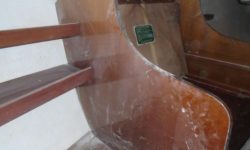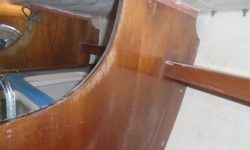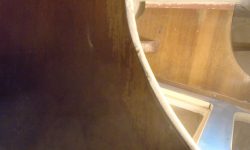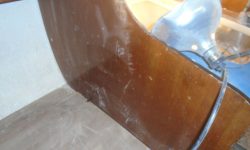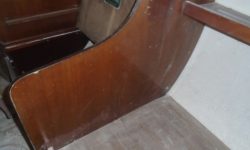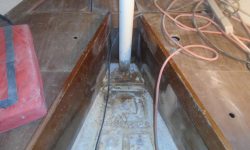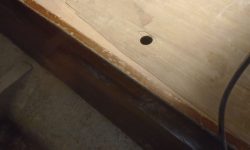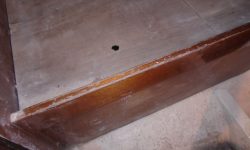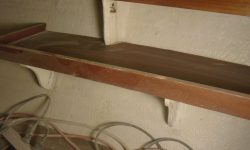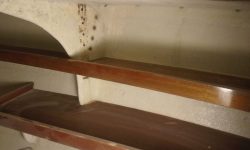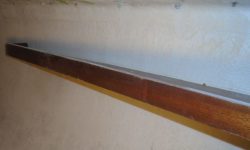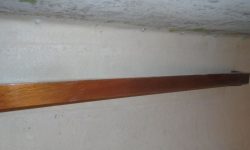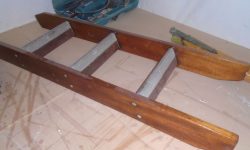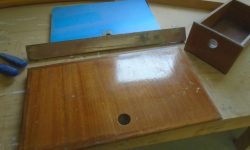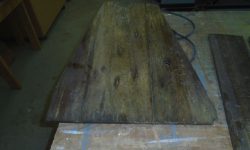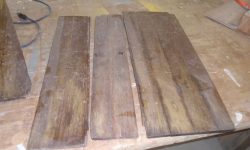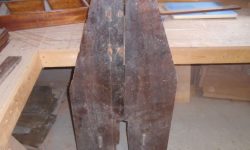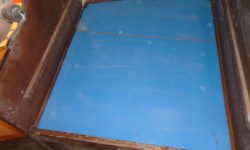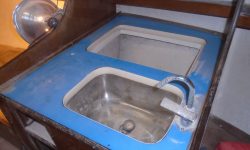January 27, 2017
Halcyon 21
Friday
Before continuing work on the exterior woodwork, I wanted to let the new sealant cure well and plenty, so I’d start the refinishing process after the weekend.
In the meantime, I spent some time in the cabin to better assess the condition of the woodwork and some of the other jobs ahead, which I also planned to start in conjunction with the exterior woodwork refinishing. I’d already sanded and prepared the hull and cabin painted areas, and would prime and paint them in due course. The original job scope also included maintenance coats of varnish on the interior bulkheads and trim, and now I turned to these areas in more detail to determine the best course of action.
The four small transverse bulkheads were in pretty good condition, with a glossy finish, but there were a few small areas where moisture had gotten behind the finish, creating discolored/yellowed areas and some failed finish beneath the surface. I could easily sand and refinish the bulkheads as is, and they’d look quite good, but this would not repair these few small areas. Previous experience with this class suggested that these bulkheads featured an epoxy coating beneath the surface finish, and this had proved quite difficult to remove on my earlier project. As a result, I hated to get into it unless necessary, though I was happy to do it if the expected results required it. It was not an immediately clear decision to me.
With only small (and not highly visible) areas of the failed coating, one could argue that there was a tenuous balance between the extra labor required not only to strip, but then sand and go through the various base and final varnish coats to build the finish anew, versus a light sanding and a maintenance topcoat. It looked like it had taken most of a full work day to strip these bulkheads on the earlier job, so this seemed a reasonable expectation here as well, plus the additional time for four or five coats versus one.
The solid wood trim located throughout the cabin, including at the edges of the berths, around the galley, and in the forward cabin, was more clear-cut: I thought most of it, but particularly the berth fiddles, needed to be stripped, sanded, and completely refinished, as there was a lot of wear on the edges of the wood, with bare spots, and unquestionably this trim would look better if redone from a fresh start.
The trim on the shelves in the forward cabin, and their counterparts above the quarterberths, was in better condition, and here it might be acceptable to lightly sand and apply a fresh coat of varnish.
Similarly, the companionway ladder, a galley drawer front, and some other removable pieces might be fine with a maintenance coat as well, not that total refinishing might not be better.
The cabin sole, in several pieces and with some damage and separation that would require some minor reassembly, was in pretty poor condition, and even a total refinishing would have its limitations, though stripping and starting from bare wood would likely have the best results.
Other work planned for the interior included revamping/refinishing, as needed, the trim around the galley countertops, as well as resurfacing the countertops with new material. The old surface was in good condition, but fairly dated in its appearance. The plastic trim pieces around the icebox and sink openings would require some attention, and perhaps re-thought, as well.
Finally, the bases of the settees and forward berth had more significant damage from moisture, particularly in the V of the forward berth, where the veneer had failed and separated from the base layers of the plywood, and in a previous consultation with the owner we’d already decided that some cosmetic repair and painting these surfaces would be the best approach, and that’s how I planned to proceed.
Total time billed on this job today: 1 hour
0600 Weather Observation:
35°, partly or mostly cloudy. Forecast for the day: sun and clouds, maybe a shower late afternoon



